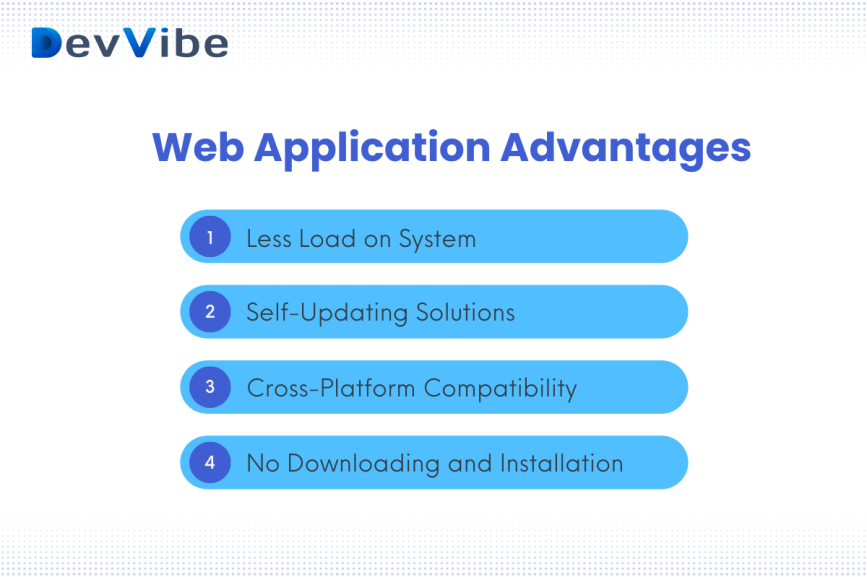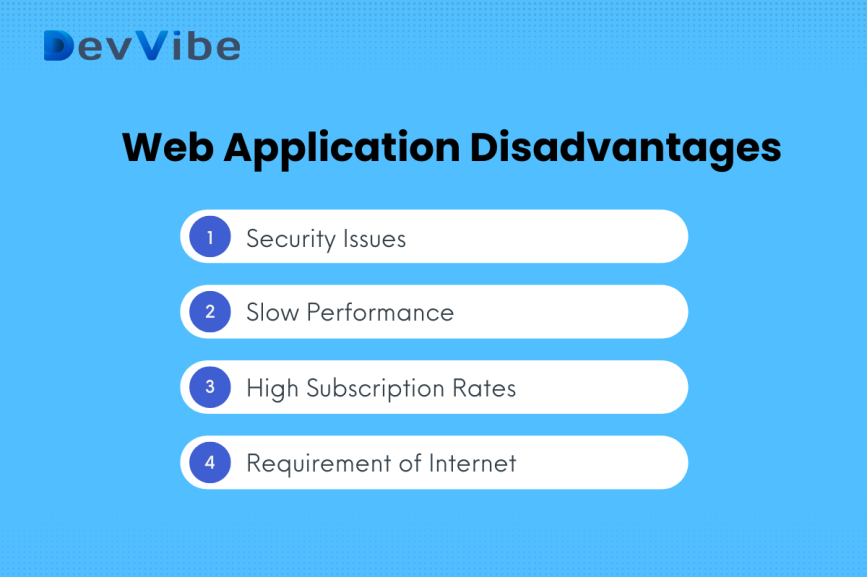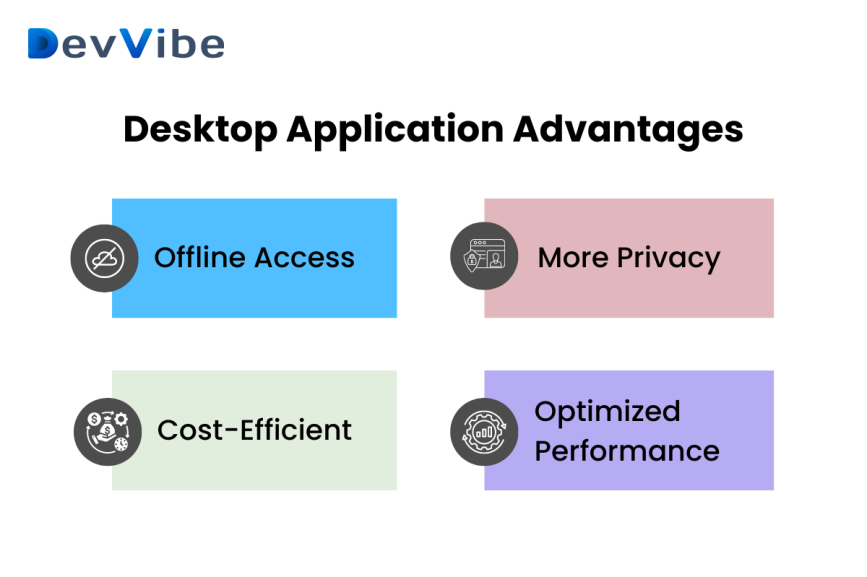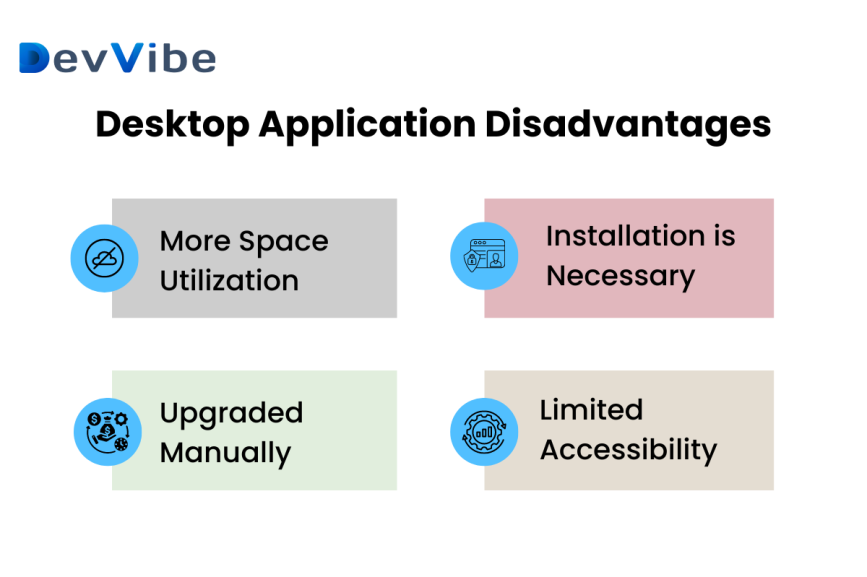
Web Application Vs Desktop Application: Pros and Cons
In today’s tech-driven world, picking the right software is crucial for businesses aiming to stay ahead. With numerous options available, understanding whether a web application or a desktop application is right for your business is crucial. This guide breaks down what makes each type of application unique, so you can make the best choice for your needs.
Keep reading further to know the difference between Web Application Vs Desktop Application.
What is a Web Application or Web App?
A web application is a software program that runs on a remote server and is accessed via a web browser. Unlike traditional desktop applications, web apps do not need to be installed on a local device. Instead, users interact with the application through an internet connection, using a web browser such as Google Chrome, Mozilla Firefox, or Safari.
How Web Applications Work
Hosting on Remote Servers: Web applications are hosted on servers that are managed by the application provider or a third-party service. These servers store all the necessary data and application logic, allowing users to access the app through their web browsers.
Browser-Based Access: Users interact with web applications via a web browser. They enter a URL, and the browser communicates with the server to retrieve and display the application.
Internet Connectivity: To use a web application, a stable internet connection is required. The application relies on the server to process and store data, which is transmitted over the internet.
Examples of Web Applications
Common examples of web applications include Google Docs, Gmail, and Facebook. These applications offer a range of services accessible through any internet-connected device.
What is a Desktop Application?
A desktop application is a software program that is installed directly onto a computer or workstation. These applications are designed to run on the local operating system and do not require an internet connection once installed. They typically utilize the computer’s resources for processing and storage.
How Desktop Applications Work
Local Installation: Desktop applications are installed on a user’s device. This involves downloading an installation package and executing it to place the application files on the local hard drive.
Offline Functionality: Once installed, desktop applications can operate without an internet connection. They use the local system resources for processing and storage, making them independent of online connectivity.
Storage and Resources: Desktop applications utilize the computer’s storage space and processing power. This can impact system performance, especially if the application is resource-intensive.
Examples of Desktop Applications: Examples include Microsoft Word, Adobe Photoshop, and AutoCAD. These applications are used for a variety of tasks, from document creation to graphic design and engineering.
Web Application Advantages
No Downloading and Installation
Immediate Access: Web applications eliminate the need for downloading and installing software. Users can access the application directly through their web browser, making it quick and easy to get started.
Space Savings: By not requiring local installation, web applications save valuable storage space on users’ devices. This is particularly beneficial for users with limited storage capacity.
Seamless Updates: Updates and patches are managed on the server side. Users always have access to the latest version without needing to manually download and install updates.
Example: Trello, a project management tool, allows users to start using the service immediately through a web browser without any installation process.
Cross-Platform Compatibility
Universal Access: Web applications can be accessed from any device with a web browser and internet connection. This includes computers, tablets, and smartphones, making them highly versatile.
Consistent Experience: Users experience a consistent interface and functionality across different devices. This facilitates smooth transitions between devices, allowing users to continue their work seamlessly.
Example: Google Drive enables users to access their files from any device, whether they are using a desktop computer, a laptop, or a mobile phone.
Self-Updating Solutions
Automatic Updates: Web applications update automatically, ensuring that users have access to the latest features and security improvements without manual intervention.
Reduced Maintenance: Users do not need to worry about managing updates, which reduces the risk of using outdated or insecure versions of the application.
Example: Slack, a messaging and collaboration tool, regularly updates its features and security protocols without requiring users to perform manual updates.
Less Load on System
Efficient Resource Usage: Since web applications run in a browser, they do not consume significant local resources such as memory and processing power. This is beneficial for users with older or less powerful hardware.
Example: Spotify’s web player allows users to stream music without installing additional software, minimizing the impact on system resources.
Web Application Disadvantages
Requirement of Internet
Dependency on Connectivity: Web applications require a stable and fast internet connection to function. Without internet access, users cannot use the application or may experience degraded performance.
Example: Google Maps requires an active internet connection to provide real-time navigation and location-based services.
Slow Performance
Internet Speed Dependency: The performance of web applications can be affected by the speed of the internet connection. Slow connections can result in lag or delays in loading and interaction.
Browser Limitations: Web applications rely on browser capabilities, which can vary across different browsers and versions, potentially affecting performance.
Example: Online games often experience lag or slow performance due to the reliance on internet speed and browser processing.
Security Issues
Online Threats: Web applications are susceptible to various online threats such as hacking, phishing, and data breaches. Ensuring robust security measures is crucial to protect user data.
Example: Equifax data breach in 2017 exposed sensitive information of millions of users due to vulnerabilities in online systems.
High Subscription Rates
Cost Considerations: Many web applications operate on a subscription-based model, requiring ongoing payments for access to advanced features or premium services.
Example: Adobe Creative Cloud offers a subscription model for access to its suite of creative tools, which can be costly for individual users or small businesses.
Desktop Application Advantages
Offline Access
No Internet Needed: Desktop applications do not rely on an internet connection for their core functionality. This is advantageous for users who need to work in environments with limited or no internet access.
Example: Microsoft Office Suite allows users to create and edit documents, spreadsheets, and presentations offline, making it ideal for work in areas without reliable internet.
More Privacy
Data Control: Data stored locally on a device is less exposed to external threats compared to data stored on remote servers. Users have greater control over their personal information.
Example: Local file management applications provide users with full control over their files and data, reducing the risk of unauthorized access.
Cost-Efficient
One-Time Purchase: Many desktop applications are available for a one-time purchase, eliminating the need for ongoing subscription fees. This can be more economical in the long run.
Example: WinRAR offers a one-time license purchase, providing users with lifetime access to the software without recurring costs.
Optimized Performance
Resource Utilization: Desktop applications can leverage the full power of the user’s hardware, leading to faster performance and better efficiency for resource-intensive tasks.
Example: Video editing software like Adobe Premiere Pro performs optimally on desktop systems with sufficient hardware resources, providing smooth editing and rendering.
Desktop Application Disadvantages
More Space Utilization
Storage Requirements: Desktop applications require significant storage space on the user’s device. This can be problematic for devices with limited storage capacity.
Example: Professional software like AutoCAD requires substantial disk space for installation and operation, which may necessitate additional storage upgrades.
Installation is Necessary
Setup Process: Installing desktop applications involves downloading and running an installer, which can be time-consuming and require administrative permissions.
Example: Game installations often involve large setup files and require specific system configurations, making the installation process more complex.
Upgraded Manually
Manual Updates: Desktop applications require users to manually download and install updates. This can be inconvenient and may lead to outdated software if not regularly maintained.
Example: Antivirus software needs frequent updates to maintain security effectiveness, requiring users to manage and install updates themselves.
Web Application vs Desktop Application – The Difference
| Feature | Web Application | Desktop Application |
| Runs on | Web browser | User’s device |
| Access | Any internet-connected device | Only from the device it’s installed on |
| Installation | No installation needed | Requires installation and takes up space on the device |
| Updates | Automatic updates by the server | Manual updates required by the user |
| Performance | Slower, depends on internet speed and browser | Faster, utilizes device resources efficiently |
| Security | Online threats possible | More secure, data stored locally |
| Example | Gmail, Google Drive, Trello | Microsoft Office, Adobe Photoshop, AutoCAD |
Wrapping Up on Web Application Vs Desktop Application
Choosing between web applications and desktop applications depends on various factors including your specific needs, budget, and working environment. Both types of applications offer unique advantages and come with their own set of challenges.
- Web Applications are ideal for users who need accessibility from multiple devices and locations, and prefer automatic updates with minimal local storage requirements.
- Desktop Applications are suited for users who require offline functionality, higher performance, and more control over their data.
Hire the Best Web Application Development Company
If you’re uncertain about which type of application best suits your needs, consulting with professionals can be invaluable. Companies like devvibe specialize in developing custom software solutions tailored to your specific requirements. Whether you opt for a web application or a desktop application, having the right expertise can ensure that you achieve the best results.
Conclusion
Both web applications and desktop applications play crucial roles in the software ecosystem. Understanding their differences, advantages, and limitations can help you make an informed decision that aligns with your goals. Whether you prioritize accessibility, performance, or cost-efficiency, there’s a solution out there for you.












